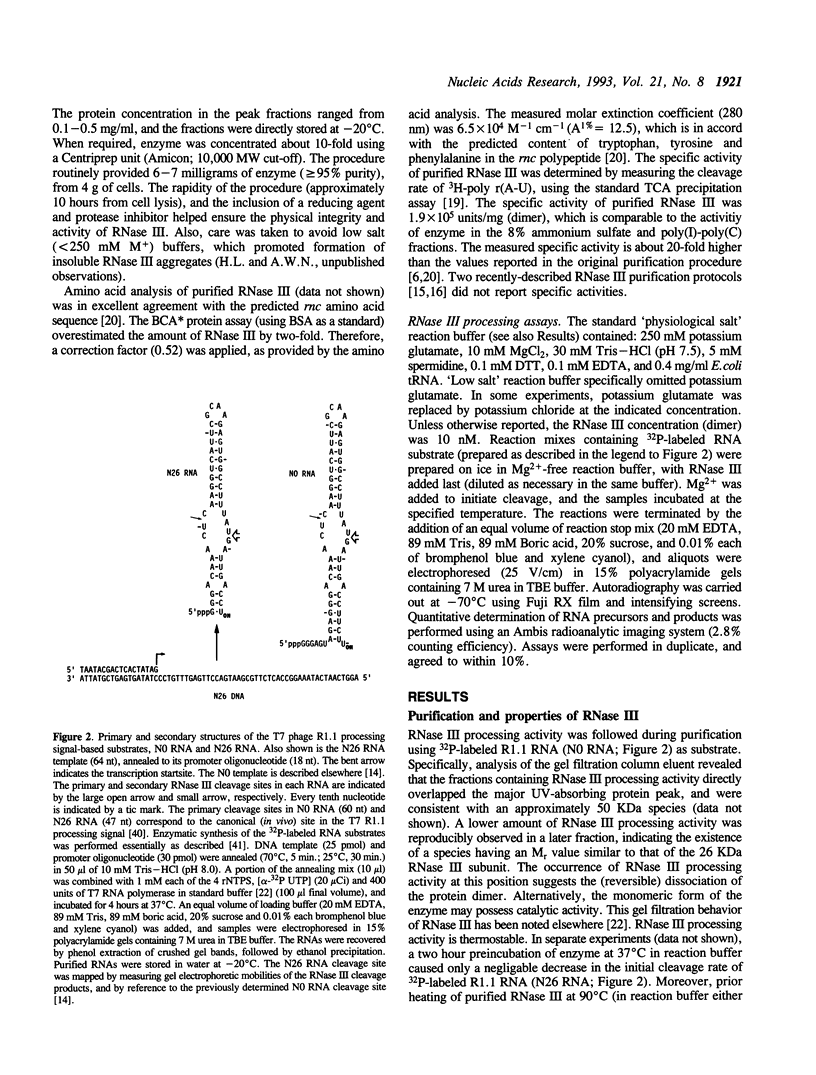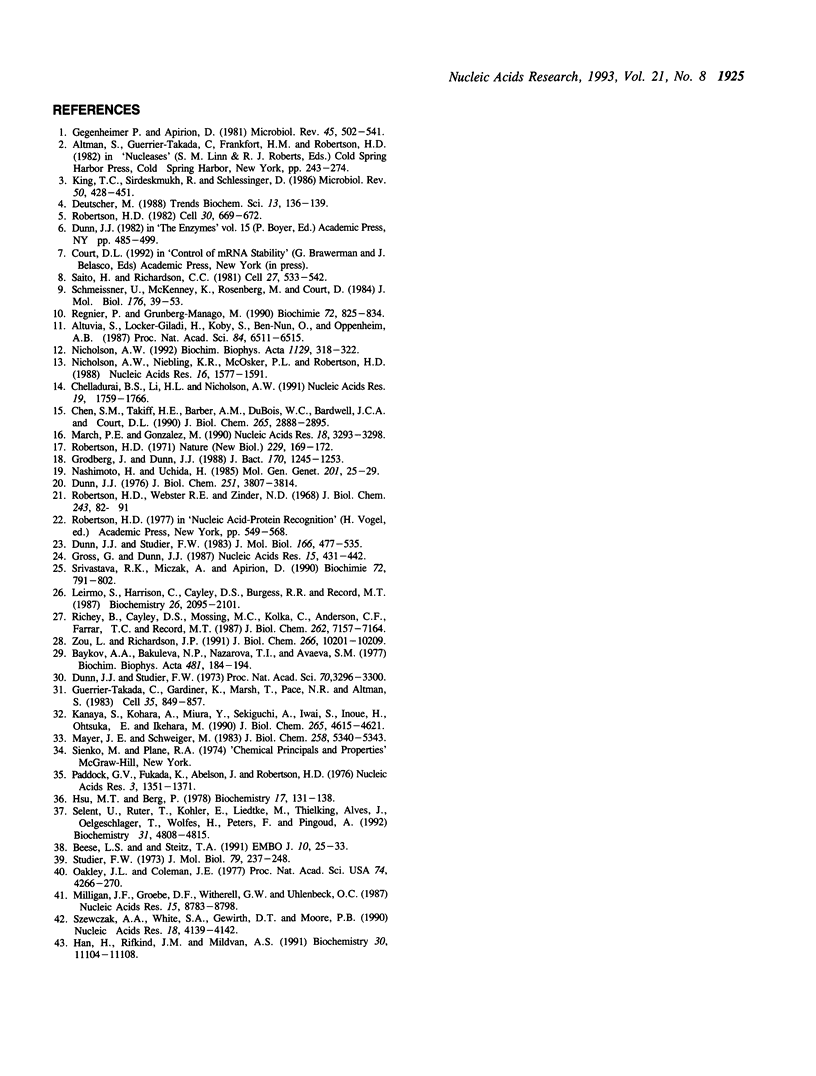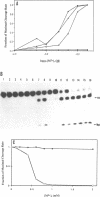Abstract
Escherichia coli ribonuclease III, purified to homogeneity from an overexpressing bacterial strain, exhibits a high catalytic efficiency and thermostable processing activity in vitro. The RNase III-catalyzed cleavage of a 47 nucleotide substrate (R1.1 RNA), based on the bacteriophage T7 R1.1 processing signal, follows substrate saturation kinetics, with a Km of 0.26 microM, and kcat of 7.7 min.-1 (37 degrees C, in buffer containing 250 mM potassium glutamate and 10 mM MgCl2). Mn2+ and Co2+ can support the enzymatic cleavage of the R1.1 RNA canonical site, and both metal ions exhibit concentration dependences similar to that of Mg2+. Mn2+ and Co2+ in addition promote enzymatic cleavage of a secondary site in R1.1 RNA, which is proposed to result from the altered hydrolytic activity of the metalloenzyme (RNase III 'star' activity), exhibiting a broadened cleavage specificity. Neither Ca2+ nor Zn2+ support RNase III processing, and Zn2+ moreover inhibits the Mg(2+)-dependent enzymatic reaction without blocking substrate binding. RNase III does not require monovalent salt for processing activity; however, the in vitro reactivity pattern is influenced by the monovalent salt concentration, as well as type of anion. First, R1.1 RNA secondary site cleavage increases as the salt concentration is lowered, perhaps reflecting enhanced enzyme binding to substrate. Second, the substitution of glutamate anion for chloride anion extends the salt concentration range within which efficient processing occurs. Third, fluoride anion inhibits RNase III-catalyzed cleavage, by a mechanism which does not involve inhibition of substrate binding.
Full text
PDF






Images in this article
Selected References
These references are in PubMed. This may not be the complete list of references from this article.
- Altuvia S., Locker-Giladi H., Koby S., Ben-Nun O., Oppenheim A. B. RNase III stimulates the translation of the cIII gene of bacteriophage lambda. Proc Natl Acad Sci U S A. 1987 Sep;84(18):6511–6515. doi: 10.1073/pnas.84.18.6511. [DOI] [PMC free article] [PubMed] [Google Scholar]
- Baykov A. A., Bakuleva N. P., Nazarova T. I., Avaeva S. M. Fluoride inhibition of inorganic pyrophosphatase. II. Isolation and characterization of a covalent intermediate between enzyme and entire substrate molecule. Biochim Biophys Acta. 1977 Mar 15;481(1):184–194. doi: 10.1016/0005-2744(77)90150-4. [DOI] [PubMed] [Google Scholar]
- Beese L. S., Steitz T. A. Structural basis for the 3'-5' exonuclease activity of Escherichia coli DNA polymerase I: a two metal ion mechanism. EMBO J. 1991 Jan;10(1):25–33. doi: 10.1002/j.1460-2075.1991.tb07917.x. [DOI] [PMC free article] [PubMed] [Google Scholar]
- Chelladurai B. S., Li H., Nicholson A. W. A conserved sequence element in ribonuclease III processing signals is not required for accurate in vitro enzymatic cleavage. Nucleic Acids Res. 1991 Apr 25;19(8):1759–1766. doi: 10.1093/nar/19.8.1759. [DOI] [PMC free article] [PubMed] [Google Scholar]
- Chen S. M., Takiff H. E., Barber A. M., Dubois G. C., Bardwell J. C., Court D. L. Expression and characterization of RNase III and Era proteins. Products of the rnc operon of Escherichia coli. J Biol Chem. 1990 Feb 15;265(5):2888–2895. [PubMed] [Google Scholar]
- Deutscher M. P. The metabolic role of RNases. Trends Biochem Sci. 1988 Apr;13(4):136–139. doi: 10.1016/0968-0004(88)90070-9. [DOI] [PubMed] [Google Scholar]
- Dunn J. J. RNase III cleavage of single-stranded RNA. Effect of ionic strength on the fideltiy of cleavage. J Biol Chem. 1976 Jun 25;251(12):3807–3814. [PubMed] [Google Scholar]
- Dunn J. J., Studier F. W. Complete nucleotide sequence of bacteriophage T7 DNA and the locations of T7 genetic elements. J Mol Biol. 1983 Jun 5;166(4):477–535. doi: 10.1016/s0022-2836(83)80282-4. [DOI] [PubMed] [Google Scholar]
- Dunn J. J., Studier F. W. T7 early RNAs and Escherichia coli ribosomal RNAs are cut from large precursor RNAs in vivo by ribonuclease 3. Proc Natl Acad Sci U S A. 1973 Dec;70(12):3296–3300. doi: 10.1073/pnas.70.12.3296. [DOI] [PMC free article] [PubMed] [Google Scholar]
- Gegenheimer P., Apirion D. Processing of procaryotic ribonucleic acid. Microbiol Rev. 1981 Dec;45(4):502–541. doi: 10.1128/mr.45.4.502-541.1981. [DOI] [PMC free article] [PubMed] [Google Scholar]
- Grodberg J., Dunn J. J. ompT encodes the Escherichia coli outer membrane protease that cleaves T7 RNA polymerase during purification. J Bacteriol. 1988 Mar;170(3):1245–1253. doi: 10.1128/jb.170.3.1245-1253.1988. [DOI] [PMC free article] [PubMed] [Google Scholar]
- Gross G., Dunn J. J. Structure of secondary cleavage sites of E. coli RNAaseIII in A3t RNA from bacteriophage T7. Nucleic Acids Res. 1987 Jan 26;15(2):431–442. doi: 10.1093/nar/15.2.431. [DOI] [PMC free article] [PubMed] [Google Scholar]
- Guerrier-Takada C., Gardiner K., Marsh T., Pace N., Altman S. The RNA moiety of ribonuclease P is the catalytic subunit of the enzyme. Cell. 1983 Dec;35(3 Pt 2):849–857. doi: 10.1016/0092-8674(83)90117-4. [DOI] [PubMed] [Google Scholar]
- Han H., Rifkind J. M., Mildvan A. S. Role of divalent cations in the 3',5'-exonuclease reaction of DNA polymerase I. Biochemistry. 1991 Nov 19;30(46):11104–11108. doi: 10.1021/bi00110a012. [DOI] [PubMed] [Google Scholar]
- Hsu M., Berg P. Altering the specificity of restriction endonuclease: effect of replacing Mg2+ with Mn2+. Biochemistry. 1978 Jan 10;17(1):131–138. doi: 10.1021/bi00594a019. [DOI] [PubMed] [Google Scholar]
- Kanaya S., Kohara A., Miura Y., Sekiguchi A., Iwai S., Inoue H., Ohtsuka E., Ikehara M. Identification of the amino acid residues involved in an active site of Escherichia coli ribonuclease H by site-directed mutagenesis. J Biol Chem. 1990 Mar 15;265(8):4615–4621. [PubMed] [Google Scholar]
- King T. C., Sirdeskmukh R., Schlessinger D. Nucleolytic processing of ribonucleic acid transcripts in procaryotes. Microbiol Rev. 1986 Dec;50(4):428–451. doi: 10.1128/mr.50.4.428-451.1986. [DOI] [PMC free article] [PubMed] [Google Scholar]
- Leirmo S., Harrison C., Cayley D. S., Burgess R. R., Record M. T., Jr Replacement of potassium chloride by potassium glutamate dramatically enhances protein-DNA interactions in vitro. Biochemistry. 1987 Apr 21;26(8):2095–2101. doi: 10.1021/bi00382a006. [DOI] [PubMed] [Google Scholar]
- March P. E., Gonzalez M. A. Characterization of the biochemical properties of recombinant ribonuclease III. Nucleic Acids Res. 1990 Jun 11;18(11):3293–3298. doi: 10.1093/nar/18.11.3293. [DOI] [PMC free article] [PubMed] [Google Scholar]
- Mayer J. E., Schweiger M. RNase III is positively regulated by T7 protein kinase. J Biol Chem. 1983 May 10;258(9):5340–5343. [PubMed] [Google Scholar]
- Milligan J. F., Groebe D. R., Witherell G. W., Uhlenbeck O. C. Oligoribonucleotide synthesis using T7 RNA polymerase and synthetic DNA templates. Nucleic Acids Res. 1987 Nov 11;15(21):8783–8798. doi: 10.1093/nar/15.21.8783. [DOI] [PMC free article] [PubMed] [Google Scholar]
- Nashimoto H., Uchida H. DNA sequencing of the Escherichia coli ribonuclease III gene and its mutations. Mol Gen Genet. 1985;201(1):25–29. doi: 10.1007/BF00397981. [DOI] [PubMed] [Google Scholar]
- Nicholson A. W. Accurate enzymatic cleavage in vitro of a 2'-deoxyribose-substituted ribonuclease III processing signal. Biochim Biophys Acta. 1992 Feb 11;1129(3):318–322. doi: 10.1016/0167-4781(92)90509-x. [DOI] [PubMed] [Google Scholar]
- Nicholson A. W., Niebling K. R., McOsker P. L., Robertson H. D. Accurate in vitro cleavage by RNase III of phosphorothioate-substituted RNA processing signals in bacteriophage T7 early mRNA. Nucleic Acids Res. 1988 Feb 25;16(4):1577–1591. doi: 10.1093/nar/16.4.1577. [DOI] [PMC free article] [PubMed] [Google Scholar]
- Oakley J. L., Coleman J. E. Structure of a promoter for T7 RNA polymerase. Proc Natl Acad Sci U S A. 1977 Oct;74(10):4266–4270. doi: 10.1073/pnas.74.10.4266. [DOI] [PMC free article] [PubMed] [Google Scholar]
- Paddock G. V., Fukada K., Abelson J., Robertson H. D. Cleavage of T4 species I ribonucleic acid by Escherichia coli ribonuclease III. Nucleic Acids Res. 1976 May;3(5):1351–1371. doi: 10.1093/nar/3.5.1351. [DOI] [PMC free article] [PubMed] [Google Scholar]
- Richey B., Cayley D. S., Mossing M. C., Kolka C., Anderson C. F., Farrar T. C., Record M. T., Jr Variability of the intracellular ionic environment of Escherichia coli. Differences between in vitro and in vivo effects of ion concentrations on protein-DNA interactions and gene expression. J Biol Chem. 1987 May 25;262(15):7157–7164. [PubMed] [Google Scholar]
- Robertson H. D. Enzymatic synthesis of bacteriophage fl DNA: RNA hybrid and double stranded RNA. Nat New Biol. 1971 Feb 10;229(6):169–172. doi: 10.1038/newbio229169a0. [DOI] [PubMed] [Google Scholar]
- Robertson H. D. Escherichia coli ribonuclease III cleavage sites. Cell. 1982 Oct;30(3):669–672. doi: 10.1016/0092-8674(82)90270-7. [DOI] [PubMed] [Google Scholar]
- Robertson H. D., Webster R. E., Zinder N. D. Purification and properties of ribonuclease III from Escherichia coli. J Biol Chem. 1968 Jan 10;243(1):82–91. [PubMed] [Google Scholar]
- Régnier P., Grunberg-Manago M. RNase III cleavages in non-coding leaders of Escherichia coli transcripts control mRNA stability and genetic expression. Biochimie. 1990 Nov;72(11):825–834. doi: 10.1016/0300-9084(90)90192-j. [DOI] [PubMed] [Google Scholar]
- Saito H., Richardson C. C. Processing of mRNA by ribonuclease III regulates expression of gene 1.2 of bacteriophage T7. Cell. 1981 Dec;27(3 Pt 2):533–542. doi: 10.1016/0092-8674(81)90395-0. [DOI] [PubMed] [Google Scholar]
- Schmeissner U., McKenney K., Rosenberg M., Court D. Removal of a terminator structure by RNA processing regulates int gene expression. J Mol Biol. 1984 Jun 15;176(1):39–53. doi: 10.1016/0022-2836(84)90381-4. [DOI] [PubMed] [Google Scholar]
- Selent U., Rüter T., Köhler E., Liedtke M., Thielking V., Alves J., Oelgeschläger T., Wolfes H., Peters F., Pingoud A. A site-directed mutagenesis study to identify amino acid residues involved in the catalytic function of the restriction endonuclease EcoRV. Biochemistry. 1992 May 26;31(20):4808–4815. doi: 10.1021/bi00135a010. [DOI] [PubMed] [Google Scholar]
- Srivastava R. K., Miczak A., Apirion D. Maturation of precursor 10Sa RNA in Escherichia coli is a two-step process: the first reaction is catalyzed by RNase III in presence of Mn2+. Biochimie. 1990 Nov;72(11):791–802. doi: 10.1016/0300-9084(90)90188-m. [DOI] [PubMed] [Google Scholar]
- Studier F. W. Analysis of bacteriophage T7 early RNAs and proteins on slab gels. J Mol Biol. 1973 Sep 15;79(2):237–248. doi: 10.1016/0022-2836(73)90003-x. [DOI] [PubMed] [Google Scholar]
- Szewczak A. A., White S. A., Gewirth D. T., Moore P. B. On the use of T7 RNA polymerase transcripts for physical investigation. Nucleic Acids Res. 1990 Jul 25;18(14):4139–4142. doi: 10.1093/nar/18.14.4139. [DOI] [PMC free article] [PubMed] [Google Scholar]
- Zou L. L., Richardson J. P. Enhancement of transcription termination factor rho activity with potassium glutamate. J Biol Chem. 1991 Jun 5;266(16):10201–10209. [PubMed] [Google Scholar]





